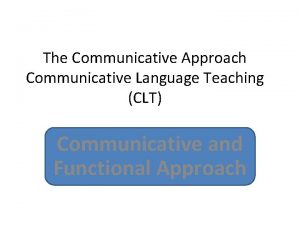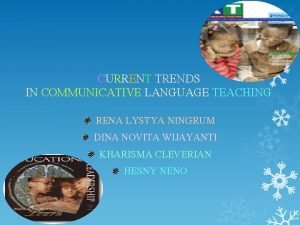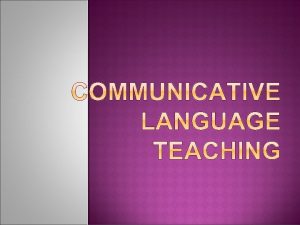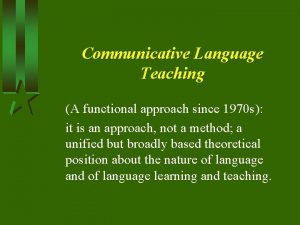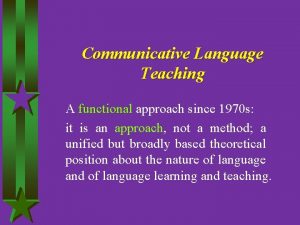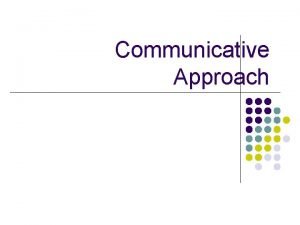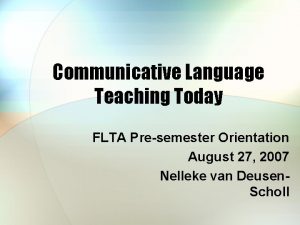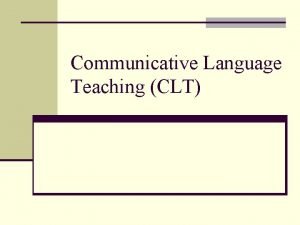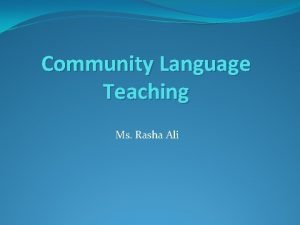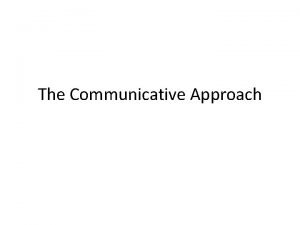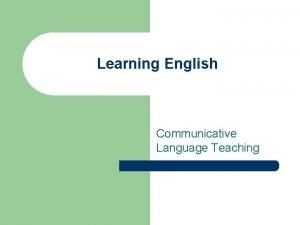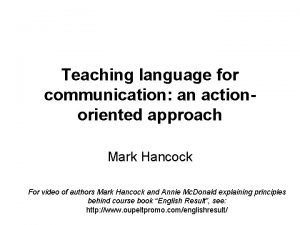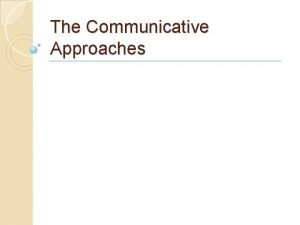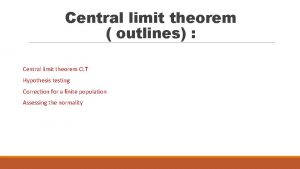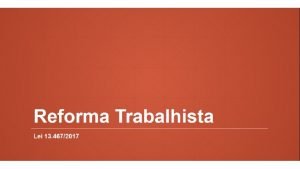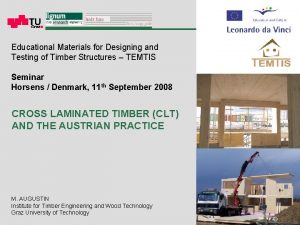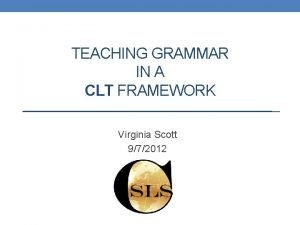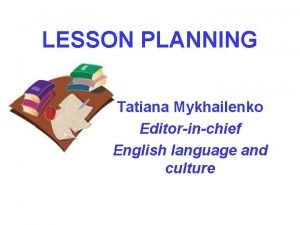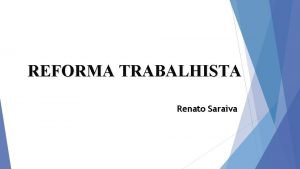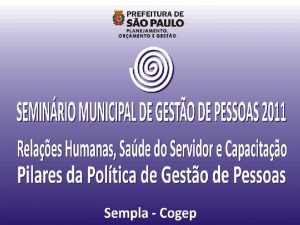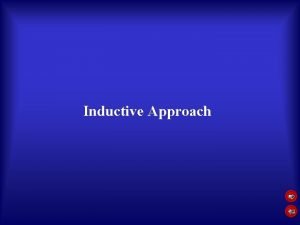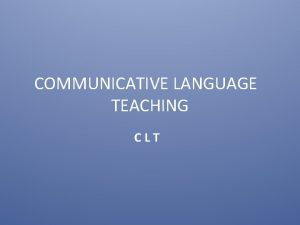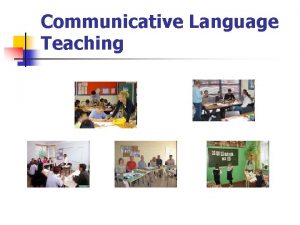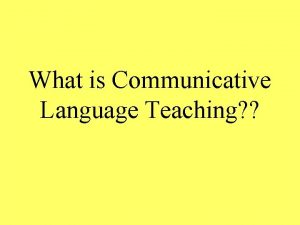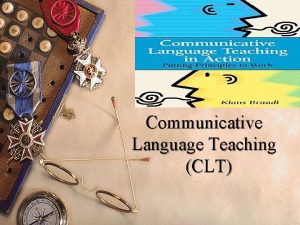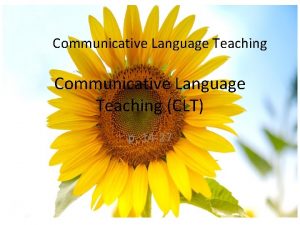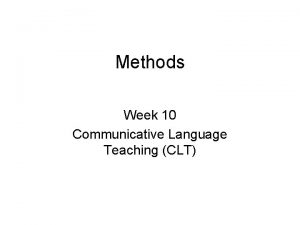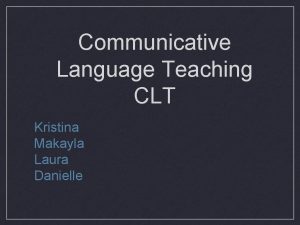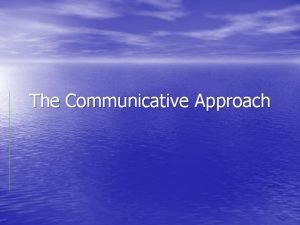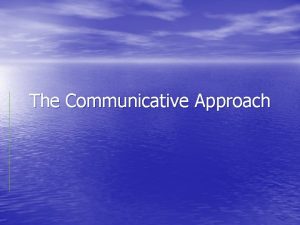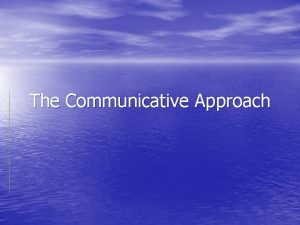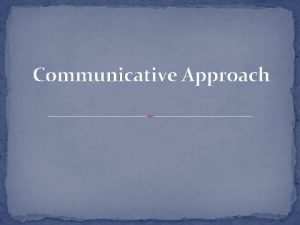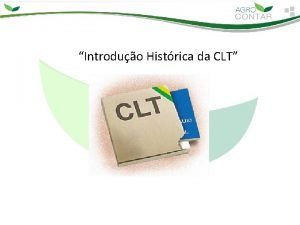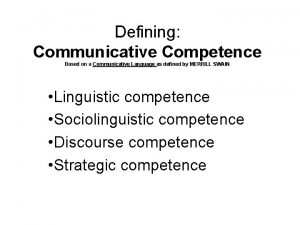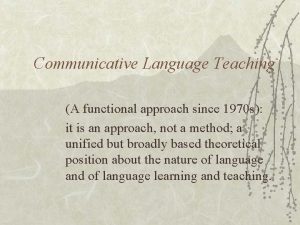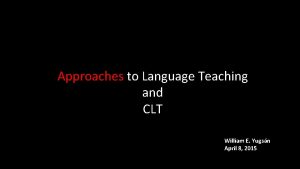The Communicative Approach Communicative Language Teaching CLT Communicative





















































- Slides: 53

The Communicative Approach Communicative Language Teaching (CLT) Communicative and Functional Approach

Background The communicative approach seeks to make meaningful communication and language use a focus of all classroom activities. The method came as a reaction against the grammar-based approaches such as the audiolingual method and grammartranslation methods of foreign language instruction that ignored that the goal of language learning is COMMUNICATIVE COMPETENCE.

• In order to explain communicative competence we have to explain first what is meant by competence. Competence is the knowledge one has (of a language). Performance is the exercise of that knowledge.

Competence is of two types: • Grammatical competence, which includes knowledge of the linguistic system of a language, such as knowledge of the grammar and vocabulary of the language And • Communicative competence, which includes refers to knowing how to use language appropriately. The latter includes :

Communicative competence 1. Knowledge of rules of speaking (e. g. • Knowing how to begin and end conversations, • knowing what topics may be talked about in different types of speech events, • knowing which ‘address forms’ (e. g. Tu – vous) should be used with different persons one speaks to and in different situations 3. Knowing how to use and respond to different types of speech acts, such as requests, apologies, thanks, and invitations. (e. g. -thank you – you’re welcome).

• The communicative approach was developed particularly by British applied linguists (Christopher Candlin and Henry Widdowson : John Firth, Halliday- Labov, Hymes, Gumprez- John Searl and John Austin) in the 1980 s • Communicative competence represents a shift in focus from the grammatical (or linguistic) competence to the communicative competence of the language.

Goal • The approach emphasizes that the goal of language learning is COMMUNICATIVE COMPETENCE (the ability to use a language to achieve one's communicative purpose / communicative intent) • The method focuses on the language needed to express and understand different kinds of functions, such as requesting, describing, expressing likes and dislikes, etc.

Purpose: Communication While grammar is still important in the CLT classroom, the emphasis is on communicating a message. CLT emphasizes communication in reallife situations since communicative competence is context specific.

Social Context Thus, CLT stresses social and situational contexts of communication. Students learn how to use language in different social contexts based on the situation, the role of the participants and the appropriate choices of register and style.

Here are examples of lg variation: - speaking with an elder or a peer (relationships of participants) – who & whom - Use of lg in different jobs or professions (formal, informal, the use of jargon or slang may or may not be appropriate. ) –when & where - Different places (market, work place…) - where

• “For example, the English statement ‘It’s rather hot in here’ could be seen as a request, particularly to someone in a lower role relationship, to close a window or door or to turn on the heating”.

Principles of CLL The major principles of Communicative Language Teaching are: 1. Enabling students to acquire the ability not only to apply the grammatical rules of a language (in order to form grammatically correct sentences) but also to know when and where to use the sentences and to whom. 2. Focus in on meaning, not form (Notions/functions). language is used to communicate 3. authentic and meaningful communication should be the goal of classroom activities 4. fluency and accuracy are both important goals in language learning. Provide opportunities for learners to learn both accuracy and fluency 5. communication involves the integration of different language skills: Link the different skills a. Make real communication the focus of language learning

Features of CLT • The use of authentic materials, authentic language use • students engage in real communication with one another • Material is presented in context • It pays attention to registers and styles in terms of situation and participants. • Fluency and accuracy (different competencies) • development of autonomous learners

Fluency vs. accuracy • Natural use of language occurring when a speaker engages in meaningful interaction and maintains comprehensible and ongoing communication despite occasional errors. • Accurate practice which focuses on creating correct examples of language use

Teacher and Student Roles • Teacher roles (1) To facilitate communication (2) To be a co-communicator • Student roles Communicator

Error correction • The instructor does not correct speech errors directly (tolerance to learner`s errors) • learning is a process of creative construction and involves trial and error

The role of the first language • Students are allowed to respond in the target language, their native language, or a mixture of the two.

• Let students induce and discover grammar rules

Advantages of the CA • (1) Students will be more motivated • (2) Students have opportunities to express themselves • (3) Student security is enhanced

• Authentic material use is encouraged through the use of: 1. Recorded conversations 2. Novels 3. Short stories

Disadvantages of the CA • Difficulty in evaluating students’ performance • Teachers should be able to use the target language fluently and appropriately

Typical techniques Scrambled sentences



Use of information gaps activities • Do you communicate to get information that you know or information you don’t know?

Use of information gaps activities • “An important aspect of communication in CLT is the notion of information gap. This refers to the fact that in real communication, people normally com- municate in order to get information they do not possess. This is known as an information gap. More authentic communication is likely to occur in the class- room if students go beyond practice of language forms for their own sake and use their linguistic and communicative resources in order to obtain information. In so doing, they will draw available vocabulary, grammar, and communication strategies to complete a task. The following exercises make use of the informa- tion-gap principle: ” • “Communicative Language Teaching Today. Classroom Activities in Communicative Language Teaching” by Jack C. Richards

• “Students are divided into A-B pairs. The teacher has copied two sets of pictures. One set (for A students) contains a picture of a group of people. The other set (for B students) contains a similar picture but it contains a number of slight differences from the Apicture. Students must sit back to back and ask questions to try to find out how many differences there are between the two pictures. Students practice a role play in pairs. One student is given the information she/he needs to play the part of a clerk in the railway station information booth and has information on train departures, prices, etc. The other needs to obtain information on departure times, prices, etc. They role-play the interaction without looking at each other’s cue cards. ” • “Communicative Language Teaching Today. Classroom Activities in Communicative Language Teaching” by Jack C. Richards

“Examples of information gap activities- Activity 1: Student B: The torn picture Que manque‐t‐il dans ta photo? You and your partner have two different parts of the picture. Exchange information to know what the people are doing on the other side. Modèle : Toi: Y a‐t‐il des gens qui descendent du bus? Ton partenaire: Non, personne ne descend du bus. Student A : The torn picture Que manque‐t‐il dans ta photo? You and your partner have two different parts of the picture. Exchange information to know what the people are doing on the other side. Modèle : Toi: Y a‐t‐il des gens qui font du vélo? Ton partenaire: Oui, une dame fait du vélo. »

Cross-word puzzle • Language games: cross-word puzzle

• ABRACADABRA ARROW BALL AND RING CHINESE RINGS CORKSCREW CRYSTAL CLEAR DEAD END DOUBLE VISIONEQUALIZER FLIGHT TEST GRAND PRIX HAVE A HEART MOUSETRAP PINETREE SHOCKWAVE SHORT CIRCUIT SILENT PARTNER SLEIGHT OF HAND SLINGSHOT SOMETHING FISHY SPUTNIK TOUCH WOOD TRIPLE CROWN TRIPLE PLAY TRIPWIRE Puzzles Find these words.

puzzle • Solving puzzles, etc. • “What thing travels round the word without leaving its place? ”

• Role plays

Picture strip story

SPOT THE DIFFERENCES

Further CLT activities A. Task- completion activities: puzzles games, map-reading. B. Information gathering activities: survey, interviews C. Information- transfer activities: question and answer

What is common among all these activities? • Emphasis on group and pair work

• Fluency and accuracy • Two types of Activities:

SAMPLE 1 • “A group of students of mixed language abilities carry out a role play in which they have to adopt to specified roles and personalities provided for them on cue cards. These roles involve the driver, witness, and the policeman at a collision between two cars. The language is entirely improvised by the students”

Activities focusing on fluency • The use of language. Classroom/ natural? • Focus of the task? • Use of language in context or out of context? • The use of any communication strategies? • Is the type of language produced predictable? • Natural • Achieving communication • Meaningful use of language in context • Requires the use of communication strategies • Non predictable

SAMPLE 2 “Students are practicing dialogs. The dialogs contain examples of falling intonation in whquestions. The class is organized in groups of three. Two students practicing the dialog and the third one playing the role of the monitor who checks that the others are using the correct intonation pattern and correct them where necessary. The students rotate their role between those monitoring and those reading. The teacher moves around listening to the groups and corrects them where necessary. ”

Activities focusing on accuracy • Natural use of language/ classroom language? • Achieving communication/ uttering correct examples of intonation? • Use of language in context/ practice small sample of language? • Need meaningful communication? • Free choice of language? • Classroom language • Focus on the formation of correct examples of language • practice samples of language. • Does not require meaningful communication • Choice of language is controlled.

Accuracy or fluency? • “Students in groups of three or four complete an exercise on a grammatical item, such as choosing between the past tense and the present perfect, an item which the teacher has previously presented and practiced as a whole class activity. Together students decide which grammatical form is correct and they complete the exercise. Groups take turns reading out their answers. ”

Accuracy or fluency? • “The teacher and a student act out a dialog in which a customer returns a faulty object she has purchased to a department store. The clerk asks what the problem is and promises to get a refund for the customer or to replace the item. In groups, students now try to recreate the dialog using language items of their choice. They are asked to recreate what happened preserving the meaning but not necessarily the exact language. They later act out their dialogs in front of the class. ”

Mechanical, meaningful, and communicative practice mechanical • Controlled practice activity • Carried without necessarily understanding the language they are using.

Mechanical, meaningful, and communicative practice Meaningful practice • language control is still provided • students are required to make meaningful choices.

Mechanical, meaningful, and communicative practice Communicative practice • Use of language within real communicative context • Real information is exchanged • Language use is totally not predictable

Sample of these activities.

The Impact • “Communicative language teaching led to a reexamination of language teaching goals, syllabuses, materials, and classroom activities and has had a major impact on changes in language teaching world wide. Some of its principles have been incorporated into other communicative approaches, such as Task. Based Language Teaching, Cooperative Language Learning, and Content-Based Instruction. ”

• British and American proponents of CLT consider it as an approach (not a method) that aims to (a) make communicative competence the goal of language teaching and (b) develop procedures for the teaching of the four language skills that acknowledge the interdependence of language and communication.

• Here, Littlwood (1981: 1) states: “One of the most characteristic features of CLT is that it pays systematic attention to functional as well as structural aspect of language. ” • More and more, Howatt distinguishes between a strong and a weak version of CLT:

There is, in a sense, a strong version of the communicative approach and a weak version. The weak version which has become more or less standard practice in the last ten years, stresses the importance of providing learners with opportunities to use their English for communicative purposes and, characteristically, attempts to integrate such activities into a wider program of language teaching… The strong version of communicative teaching, on the other hand, advances the claim that the language is acquired through communication…(1984: 279)

• “Which of the statements below do you think characterizes communicative language teaching? • 1. People learn a language best when using it to do things rather than through studying how language works and practicing rules. • 2. Grammar is no longer important in language teaching. • 3. People learn a language through communicating in it. • 4. Errors are not important in speaking a language. • 5. CLT is only concerned with teaching speaking. • 6. Classroom activities should be meaningful and involve real communication. • 7. Dialogs are not used in CLT. • 8. Both accuracy and fluency are goals in CLT. • 9. CLT is usually described as a method of teaching. ”

• “Communicative Language Teaching Today” by Jack C. Richards (http: //www. cambridge. org/other_files/down loads/esl/booklets/Richards-Communicative. Language. pdf • http: //cambridge. hwatai. com. tw/webpage/09 /e_connection/april/epapper_200904_1. htm
 Picture strip story in communicative language teaching
Picture strip story in communicative language teaching Lystya
Lystya Background of communicative language teaching
Background of communicative language teaching Communicative language teaching
Communicative language teaching Communicative language teaching
Communicative language teaching Communicative language teaching
Communicative language teaching Jack richards communicative language teaching today
Jack richards communicative language teaching today Language
Language Picture strip story in communicative language teaching
Picture strip story in communicative language teaching Define communicative approach
Define communicative approach Communicative language teaching
Communicative language teaching History of direct method
History of direct method What is language based approach in teaching literature
What is language based approach in teaching literature Top down approach in teaching
Top down approach in teaching Action-oriented approach in language teaching
Action-oriented approach in language teaching Clt syllabus
Clt syllabus Central limit theorem
Central limit theorem Leis trabalhistas
Leis trabalhistas Clt production process
Clt production process Clt production
Clt production Clt framework
Clt framework Straight arrow lesson plan
Straight arrow lesson plan Art 193 clt
Art 193 clt Art 843 clt reforma trabalhista
Art 843 clt reforma trabalhista Readaptação funcional clt
Readaptação funcional clt Scale down teaching
Scale down teaching Inductive teaching approach
Inductive teaching approach Direct or expository approach
Direct or expository approach Top down strategies in listening
Top down strategies in listening What is deductive method
What is deductive method Communicative achievement in writing
Communicative achievement in writing Virtual circuits and datagram networks
Virtual circuits and datagram networks Theoretical models of counseling
Theoretical models of counseling Waterfall and sprinkler strategy
Waterfall and sprinkler strategy Approach approach conflict
Approach approach conflict Bandura's reciprocal determinism
Bandura's reciprocal determinism What is a research
What is a research Traditional approach vs object oriented approach
Traditional approach vs object oriented approach Tony wagner's seven survival skills
Tony wagner's seven survival skills Hình ảnh bộ gõ cơ thể búng tay
Hình ảnh bộ gõ cơ thể búng tay Frameset trong html5
Frameset trong html5 Bổ thể
Bổ thể Tỉ lệ cơ thể trẻ em
Tỉ lệ cơ thể trẻ em Voi kéo gỗ như thế nào
Voi kéo gỗ như thế nào Tư thế worm breton
Tư thế worm breton Alleluia hat len nguoi oi
Alleluia hat len nguoi oi Các môn thể thao bắt đầu bằng tiếng chạy
Các môn thể thao bắt đầu bằng tiếng chạy Thế nào là hệ số cao nhất
Thế nào là hệ số cao nhất Các châu lục và đại dương trên thế giới
Các châu lục và đại dương trên thế giới Công thức tính độ biến thiên đông lượng
Công thức tính độ biến thiên đông lượng Trời xanh đây là của chúng ta thể thơ
Trời xanh đây là của chúng ta thể thơ Mật thư tọa độ 5x5
Mật thư tọa độ 5x5 Làm thế nào để 102-1=99
Làm thế nào để 102-1=99 độ dài liên kết
độ dài liên kết
